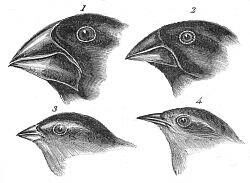Born in 1809, Charles Darwin is considered the father of the theory of evolution, which revolutionized the world of science. This English naturalist is known for, among other things, explaining the mechanism that leads to the emergence of species: natural selection.
Natural selection is the mechanism that suggests that the best adapted individuals of a species will survive and reproduce. From one generation to the next, individuals become better and better adapted to their environment because genes related to advantageous character traits are passed down to the offspring.

During one of his many trips, Darwin went to the Galapagos Islands, where he noticed that the different species of finches populating the islands seemed to be related. Upon returning from his trip, inspired by his observations, he wrote one of his most influential works, On the Origin of Species by Means of Natural Selection.
Darwin’s finches included over a dozen species, all similar in colour (brown or black). He noticed that the main differences were in the size and shape of their beaks. Since resources differed from one island to the next, so did the finches’ diets, which explains these differences.

Darwinism is based on these six principles:
-
Evolution
Species are not set and permanent; they transform over time.
-
Common ancestor
Each group of organisms (animals, plants, microorganisms, etc.) comes from a common ancestor. The offspring of this ancestor would have spread across various habitats and accumulated changes allowing them to survive.
-
Multiplication of species
Species can multiply, either by separating into “daughter species” or by isolating a small group of individuals from the rest of a population.
-
Gradualism
Evolutionary changes occur as a result of gradual changes in populations.
-
Natural selection
Evolutionary changes arise from the great phenotypic variability of individuals in a population. Over generations, due to a combination of beneficial character traits inherited from their parents, only the best adapted individuals will be involved in establishing the next generation.
-
Sexual selection
Many animals have cumbersome traits that hinder their survival (peacock’s tail, deer’s antlers). Sexual selection explains that these traits must be preserved because they are essential to the reproduction of their carrier. It is these traits that allow the carrier to defeat other males or impress females.